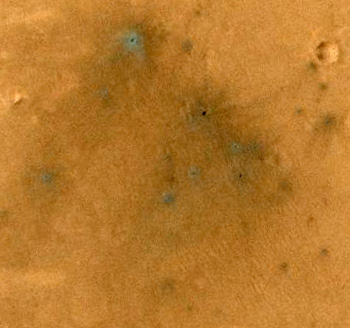The great Martian dust storm of 1971.
The great Martian dust storm of 1971.
There has only been one comparable global dust storm on Mars since then. What made the 1971 even more significant historically is that the first human orbital probe had arrived at that very moment to record it.
By late 1971 and into January 1972 the storm abated, and Mariner 9 began to send back some spectacular images – a total of over 7,300 pictures that mapped the entire martian surface with resolutions ranging from 1 kilometer per pixel to as good at 100 meters per pixel.
The image here gives a sense of the magnitude of the storm. This was what the scientists began to see as the dust settled. The only visible features are the three great Tharsis Montes shield volcanoes, poking up through the haze in a line. The tallest of these reaches an altitude of over 18 kilometers. These peaks, and the enormous bulk of Olympus Mons had never been imaged by a spacecraft before, earlier flybys had missed them.
The late Bruce Murray (Caltech) was on the camera team and recalls, “there was a gradual clearing, like a stage scene, and three dark spots showed up.” The Mars that came out of the storm was a revelation, from these colossal mountains to the great rift of Valles Marineris and the steep valleys of Noctis Labyrinthus.
The great Martian dust storm of 1971.
There has only been one comparable global dust storm on Mars since then. What made the 1971 even more significant historically is that the first human orbital probe had arrived at that very moment to record it.
By late 1971 and into January 1972 the storm abated, and Mariner 9 began to send back some spectacular images – a total of over 7,300 pictures that mapped the entire martian surface with resolutions ranging from 1 kilometer per pixel to as good at 100 meters per pixel.
The image here gives a sense of the magnitude of the storm. This was what the scientists began to see as the dust settled. The only visible features are the three great Tharsis Montes shield volcanoes, poking up through the haze in a line. The tallest of these reaches an altitude of over 18 kilometers. These peaks, and the enormous bulk of Olympus Mons had never been imaged by a spacecraft before, earlier flybys had missed them.
The late Bruce Murray (Caltech) was on the camera team and recalls, “there was a gradual clearing, like a stage scene, and three dark spots showed up.” The Mars that came out of the storm was a revelation, from these colossal mountains to the great rift of Valles Marineris and the steep valleys of Noctis Labyrinthus.

